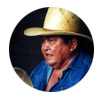A Dreamer's Drum
On June 28th, 2005, a group of Dane-zaa elders, young people, linguists, and anthropologists met at our Doig River First Nation's Cultural Centre to plan this website. Chief Gary Oker came to the meeting carrying a drum skin that had been in safe storage in his home for many years. Chief Oker had inherited the drum from his late grandfather, the songkeeper Albert Askoty who had been given the drum to care for by the Dreamer Charlie Yahey; since Albert's death, the drum had rarely been seen by our Dane-zaa community.
Some of the elders at the meeting recognized the drum as one made by the Dreamer Gaayęą, who lived in the late 19th and early 20th centuries and who was a teacher for Charlie Yahey. They remembered stories about Gaayęą's life, and the story of his death in 1923 at Suunéch'ii Kéch'iige (Montney).
Dane-zaa Dreamers like Gaayęą received songs from Heaven in their dreams; they often drew maps of their visions from Heaven on tanned moose hides and on the skins of their drums. Gaayęą's drum is now fragile with age and torn from its frame, but the elders at the meeting identified the paintings on the drum as symbolic images central to the Dane- zaa Creation Story. They also recognized the drum's value for teaching about Dane-zaa history and traditions.
The drum inspired Tommy Attachie, who is now the songkeeper for our people, to talk about the ways in which the drum is tied to Dane-zaa history, memory, land use, spirituality, and survival. Speaking in Dane-zaa Záágéʔ (Beaver Language), Tommy told everyone present - elders, youth, ethnographers and linguists - that they should travel to those places in Dane-zaa territory where the Dreamers used to camp, and tell "the important stories" (view this clip)
In this way, those who attended that planning meeting decided that Gaayęą's drum would be a central symbol and guiding metaphor for this project: Dane Wajich - Dane-zaa Stories & Songs: Dreamers and the Land.. However, over the course of the development of this website, our Doig River elders and community members also came to a consensus that it is not appropriate to show Dane-zaa Dreamers' drawings to a world wide audience on the Internet. Even though the drum is central to this website, in order to ensure that the Dreamers drawings are treated properly and with respect, no images of Dreamers' drawings or the drum that we describe here are shown.
A Dreamer's Drum Photos:
Slide show not displaying? Click here to view images
Stories

Tommy Attachie, talking about the significance of the Dreamer Gaayęą's drum.
Tommy Attachie speaks in Beaver at a project planning meeting. He connects the Dreamer Gaayęą's drum to Dane-zaa dreaming, hunting, and oral traditions, using these principles to direct the project team to document the material you see throughout this website. Doig River First Nation Cultural Centre, 2005.

Mark Apsassin, talking about his life and his interpretation of the Dreamer Gaayęą's Drum. Doig River, 2005.
Mark interprets the drawings on the Dreamer Gaayęą's drum and relates their symbolism to his present experience. Doig River First Nation Rodeo Grounds, 2005.
Songs

Tommy Attachie singing a prayer song by the Dreamer Nááchę (John Notseta), circa 2001.
Tommy Attachie sings a prayer song dreamed by the Dreamer Nááchę (John Notseta), Petersen's Crossing, circa 2001. Tommy says this is an important song used by Dane-zaa to give them strength during hard times.




